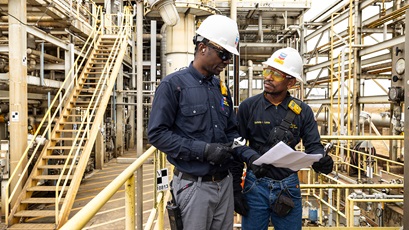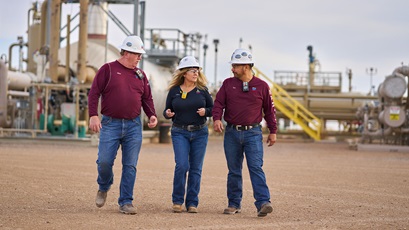our operations
drone technology takes safety to new heights in el segundo
1 min read | september 08, 2022
Quoc Tran’s interest in flying drones predates his tenure with Chevron.
As a hobbyist, he has long used them for travel and filmmaking; as a process engineer in El Segundo, California, he began piloting drones to inspect refinery equipment in June 2020.
“When I got here, I thought, ‘Let’s see where this technology can take me in my actual job,’” Tran said.
safety first
Chevron’s top priority will always be the safety and well-being of our employees and the communities in which we operate. We continually explore ways to improve safety.
Tran recently used a camera-equipped drone to inspect three pieces of equipment at our El Segundo Refinery—a low pressure separator, a heat exchanger and a steam drum.
Using the drone mitigated some of the risks associated with a typical inspection. With more development, this technology has the potential to make refinery maintenance safer.
why it matters
In-person inspections in confined spaces and inside equipment can be complicated.
“When you’re in there, you might be overwhelmed,” Tran said. “If it’s your first time or you aren’t an experienced inspector or process engineer, you may need to go in multiple times. But if you have a drone, you can fly in and take a recording.”
The recording can eliminate the need for multiple in-person inspections. It also serves as a permanent data source and visual reference for the inspector as well as other refinery personnel.

how it works
A turnaround is a planned shutdown of process units for maintenance, upgrades, repairs, testing, inspection and other activities. It’s a complicated, lengthy and expensive undertaking that involves shutting and isolating equipment.
Construction of scaffolding for work at height may be among the hundreds of tasks that must be performed to enable safe access. As for inspectors like Tran, they are required to wear personal protective equipment (PPE)—half masks, full masks, hazmat suits, harnesses and more—before entering a unit.
“You have a lot of things hanging off you, so maneuvering can be a challenge,” Tran said. “With drones, we can perform a swift inspection and then review the footage. If we see something that needs more attention, we can go take a look.”
where we go from here
As battery life, drone size and cameras improve, drones could be used to further reduce the number of in-person process unit entrances.
“It’s great for safety,” Tran said. “If we can eliminate multiple entries, I think that’s a win.”
the big picture
Chevron continues to explore innovative tools—like drones—that can be used to improve our efficiency, safety and reliability.
topics covered
related content
-

 explainer: where do oil and gas come from?
explainer: where do oil and gas come from?our operationsdecember 30, 2024
-

 gas development opportunities in sub-saharan Africa
gas development opportunities in sub-saharan Africaour operationsdecember 20, 2024
-

 AI boosts profitability in the permian basin
AI boosts profitability in the permian basinour operationsdecember 18, 2024
-

 new california legislation misleading, chevron exec says
new california legislation misleading, chevron exec saysour operationsnovember 26, 2024
chevron email updates
Subscribe to our newsletter to receive news and updates.



